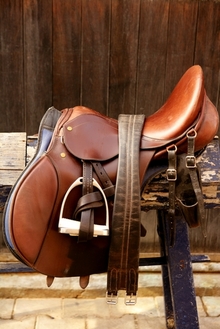It’s happening more and more, and often in broad daylight: bold, brazen thieves are walking into the barns and tackrooms of unsuspecting horsemen, and walking right back out with stolen tack and equipment. The worst part? The thieves are usually people in the industry who sell the stolen items right back into the horse community.

Saving horse owners from saddle theft
Saddle Network tags give the owner the ability to quickly notify the community via the Saddle Network website and social networking if the saddle has been stolen or lost.
Saddle Network’s solution to saddle theft begins with an equipment archiving system and a three inch flat, aluminum tag created to military specifications. The tag, which contains item description, pictures and status information, is easily and permanently affixed with rivets. Tags give the owner the ability to quickly notify the community via the Saddle Network website and social networking if the saddle has been stolen or lost.
“Working side by side with trainers and riders for over a decade, we found ourselves asking the questions, ‘what if we could stop theft before it ever happened?’” explains Saddle Network Founder Mary Braly. “We then realized that the solution was right in front of us, all around us, and in what we use everyday.”
That solution combines the very latest technology with the power of social networking to assist the close knit equestrian community in preventing saddle theft – before it happens!
Saddle Network introduces a revolution in theft prevention with its innovative system of tagging, archiving, and social networking to track saddles.
The key is visible tagging, combined with a platform of community watch that aims to change the old, reactive way that victims and thieves alike respond to theft. It is fairly simple for a thief to swipe a saddle when opportunity arises, quickly resell it to an unsuspecting buyer, and walk away with the cash.
Currently, people who don’t want to be a victim of saddle theft do not have an effective way to protect themselves before theft happens. Their saddle can be covered and hidden, it can be stored inside a tackroom, it can even be locked in a trailer, but once exposed to a clever thief who finds it, it’s most often as good as gone.
Tags give the owner the ability to quickly notify the community via the Saddle Network website and social networking if the saddle has been stolen or lost.
In turn, the public can access the item’s information immediately by scan of the QR code on the tag or directly at the website. This gives anyone the ability to easily check a saddle’s current status, such as stolen or lost.
In order to maintain continuity and legitimacy, Saddle Network has pre-determined a tag placement location for both English and Western saddles that is unique to the Saddle Network tag. This in turn makes it easy to recognize if a saddle is protected or unprotected and if a tag is missing.
This continuity also serves as a warning to thieves that the saddle is registered and protected. If they attempt to take it there’s a good chance they will be caught!
The United States Hunter/Jumper Association has reviewed Saddle Network, and states that tagged saddles will not affect a rider’s score in the hunter ring whatsoever. In fact, USHJA CEO Shelby French states, "I think Saddle Network is very timely and a terrific idea that can have a very beneficial impact on our industry. We look forward to working with Saddle Network."
There is much more to come from Saddle Network. Take a minute to check out SaddleNetwork.com, and follow them on Facebook for up to date news. Saddle Network launches on September 25th, and Pre-Launch signups are available now!
